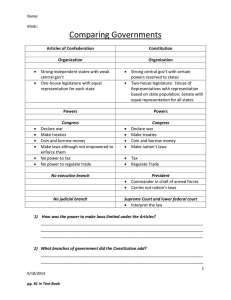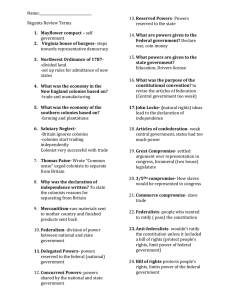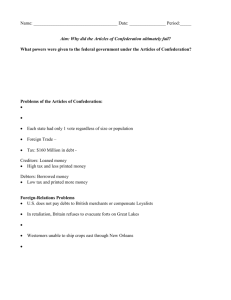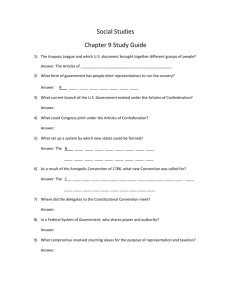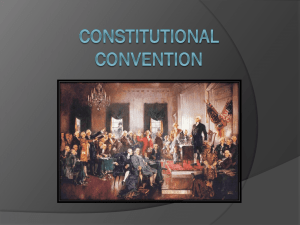Chapter 5 Section 2: The Constitutional Convention
advertisement
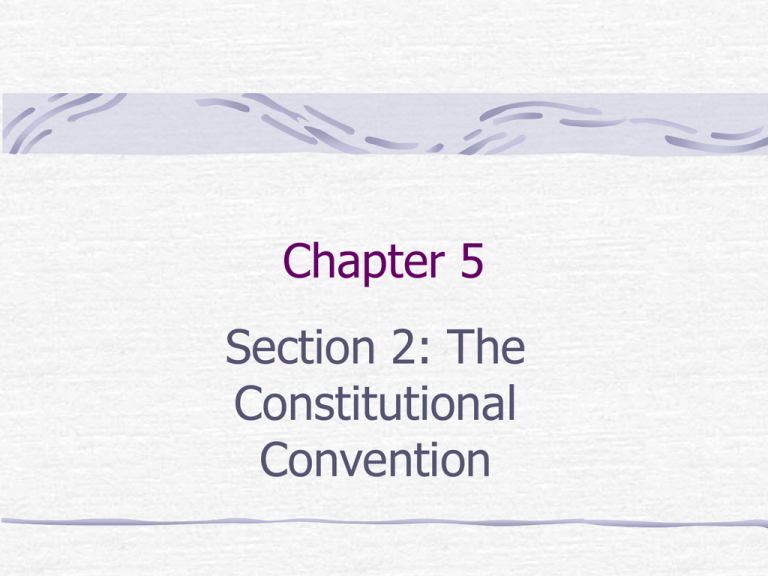
Chapter 5 Section 2: The Constitutional Convention The Convention Assembles May 1787 Known as the Constitutional Convention Produced the US Constitution 55 delegates from all states except RI “The Father of the Constitution” James Madison Attended every meeting & busily took notes Studied law, history, & government Drew from philosopher Jean Jacques Rousseau Through proper government, humans could take control of themselves & their world & improve the condition of both Divisions at the Convention Elected Washington as President by unanimous vote Major division was amending the Articles or abandoning them all together If to get rid of them, they would have to over step their powersthat’s what they did The Virginia Plan Submitted by Edmund Randolph Bicameral legislature based on population Provisions Legislature would have added powers- right to tax & regulate foreign & interstate commerce Legislature would have veto power Government would have an executive & judicial branch too New Jersey Plan Proposed by William Patterson Features Congress had the power to tax & regulate foreign & interstate commerce Create executive & judicial branches Every state would have an equal vote in a unicameral Congress Aimed to keep state government more powerful Reaching Agreements The Great Compromise Introduced by Roger Sherman of Connecticut & Oliver Ellsworth Legislative branch made up of 2 houses Senate- Equal representation 2 per state House of RepresentativesBased upon population Approved July 16, 1787 The Three Fifths Compromise Should slaves be included in the population count? South would have great power in the House 3/5 of a state’s slave population would be counted A Lasting Document Final draft approved September 17, 1787 Many strengths to help it endure Flexible to adapt Amendments (How many?) Many nations have modeled their governments after the US Government Structure Federal & State Powers Federal system of government Reserved powers- reserved for the states Delegated powers- delegated to the Federal government Concurrent powers- shared Separation of Federal Powers Separation of powers Each branch has its own area of authority but no one branch has complete power over the government Checks & balances Prevents tyranny Congress Preserved & limited the people’s control over the government House is directly responsible to the people 2 year term Senate Originally elected by state legislatures Changed in 1913 by 17th amendment 6 year terms Every 2 years 1/3 of the Senate is reelected Less influence of popular opinion Advise & consent to the President with regard to treaties & judicial appointments Can coin money, declare war, raise an army, provide for a navy, & regulate commerce “Elastic clause” Necessary & proper The President Term is 4 years & could be reelected as many times as wished nd 2 term limit set by the 22 Amendment in 1951 President is chosen by a group of electors from each state Number of Congressmen Electoral College House is the final decision maker if no one wins the vote Vote until one candidate receives majority Powers Commander in chief of armed forces, power to veto Congress, choose judges for the national courts Federal Courts Removal of judges is difficult so people can’t control them Hold office for life, unless they act dishonestly The Road Ahead Constitution required the approval of 9 out of the 13 states

